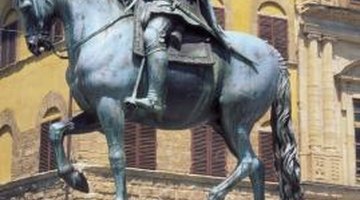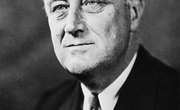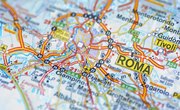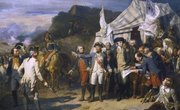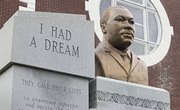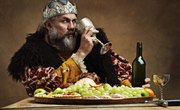Cosimo de Medici, born in Florence in 1389, was classically educated to prepare him to take over the family's banking business. Medicis were accomplished at leveraging commerce into political power -- Cosimo's father, Giovanni, was the last of the Medici gonfalonieri, one of nine elected officials who ran the city-state of Florence. Giovanni's heirs preferred to rule from behind the scenes and, starting with Cosimo, they played princely roles in the economic, cultural and political life of Florence and Renaissance Italy.
Cosimo, Prince of Florence
Cosimo de Medici never held elective office, but he was generally acknowledged to be the patriarch of Florence. He assured Medici prominence by expanding the family's banking business to absorb most of the rest of Florence's banks and made enemies of the other wealthy families -- the Albizzi, the Pazzi and the Borgias. Cosimo's extravagant encouragement of the arts, his influence over daily life in Florence, his ambitions for the city and his own family's ascendancy resulted in accusations of treason against him by his enemies, engineered by the Albizzis. He was arrested and tried, but his wealth and political connections commuted his sentence from death to a 10-year exile -- he was back in Florence, triumphant, in one year. The world owed Cosimo and the Medici Bank money. He created a vast fortune, controlled every aspect of Florentine life, was despised and admired in equal measure.
The Patron
The arts were Cosimo Medici's passion, and it was as patron of the arts that he arguably had his most significant influence. Medici patronage bankrolled the works of the architect Brunelleschi, sculptors Donatello and Ghiberti, and painters Masacchio, Sandro Botticelli, Fra Angelico, Paolo Uccello, Filippo Lippi, Piero della Francesca and Domenico Ghirlandaio, who explored three-dimensional perspective, light and shadow to replace flat religious paintings, and evolved a new style of Renaissance art. Cosimo commissioned and collected illustrated manuscripts, amassing a brilliant and vast library that preserved ancient texts and classical learning and making it available to scholars and to the public. Florence was the birthplace of Renaissance art and scholarship, and Cosimo de Medici was its leading benefactor.
The Politician
Cosimo may have been more interested in the arts, but he never neglected the political maneuvering that ensured the Medici fortune and kept him at the center of political life in Florence. He brutally contained his opponents by destroying them financially. During his time, Florence expanded its dominance of the region by annexing cities and seaports -- either by taking them militarily or by buying them outright. The historic rivalry with Milan to the north ended with a military victory over its ruling Visconti family and the rise of an ally and Medici Bank customer, Francesco Sforza, with whom Cosimo promptly forged a truce. The 1439 ecumenical council to resolve differences between the Roman Catholic pope and the Eastern Orthodox patriarch was hosted by the City of Florence and the Medicis. There was no corner of Florentine life in the Renaissance that Cosimo and the Medici family did not control.
Lorenzo, Il Magnifico
After Cosimo died in 1464, the next prominent Medici to rule Florence was his grandson, Lorenzo. Lorenzo inherited Cosimo's intellectual curiosity, lust for political power and passion for the arts. He survived an assassination attempt that killed his brother, and was sole unelected patriarch of the city-state until his own death in 1492. He earned the nickname Il Magnifico for his dashing, colorful and bold demeanor and his patronage of the geniuses of Western art. Botticelli, Michelangelo and da Vinci enjoyed his support, as did poets, writers, architects and scholars; his promotion of classical education mirrored the best impulses of Cosimo, and further eroded the dwindling Medici fortune. Despite his early death at 43, during the divisive political emergence of the fanatic puritanical monk Savonarola and the ousting of the Medici family from power, it is Lorenzo, beneficiary of his grandfather's legacy, who is considered the greatest of the Medici rulers.
Related Articles
References
Writer Bio
Benna Crawford has been a journalist and New York-based writer since 1997. Her work has appeared in USA Today, the San Francisco Chronicle, The New York Times, and in professional journals and trade publications. Crawford has a degree in theater, is a certified Prana Yoga instructor, and writes about fitness, performing and decorative arts, culture, sports, business and education .

